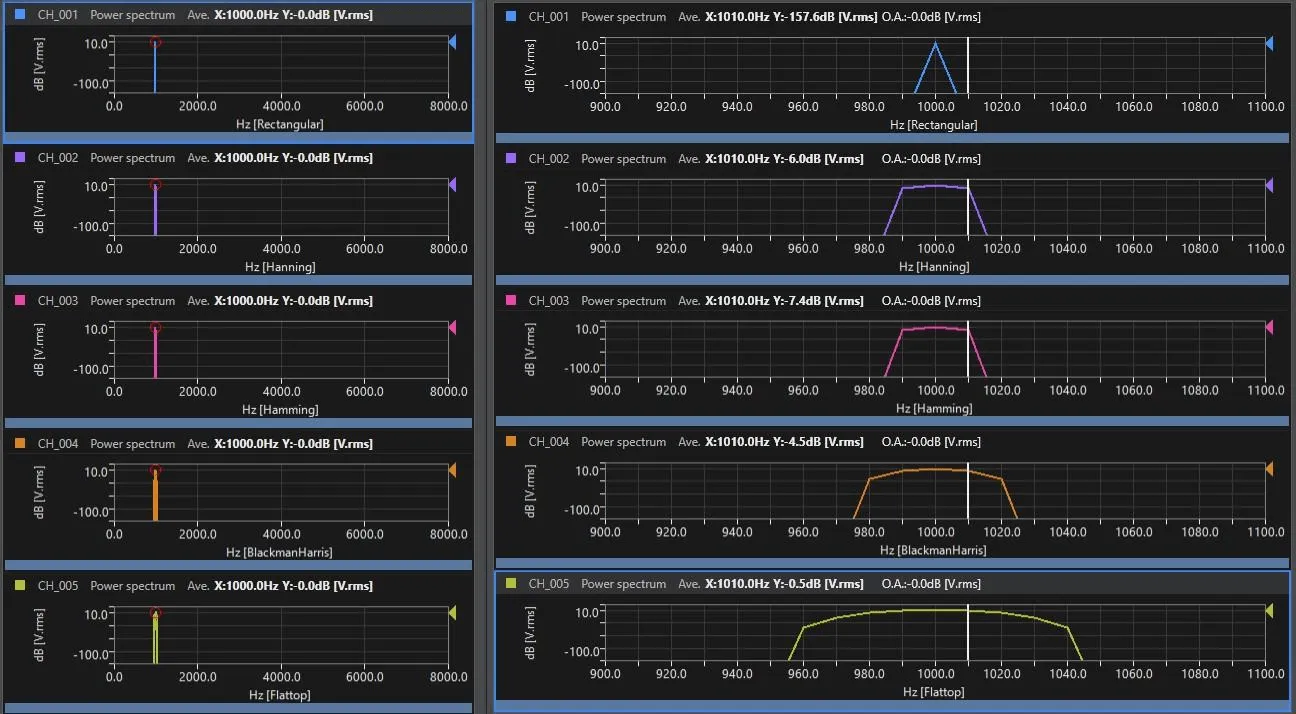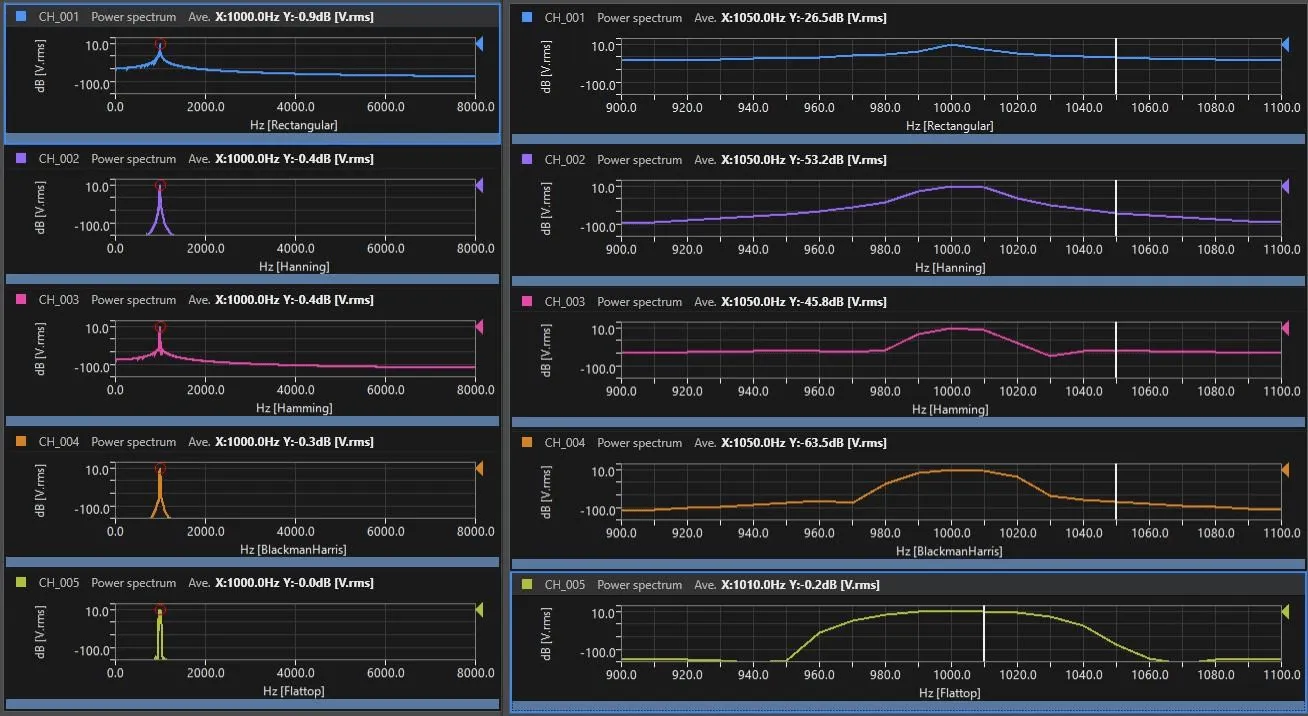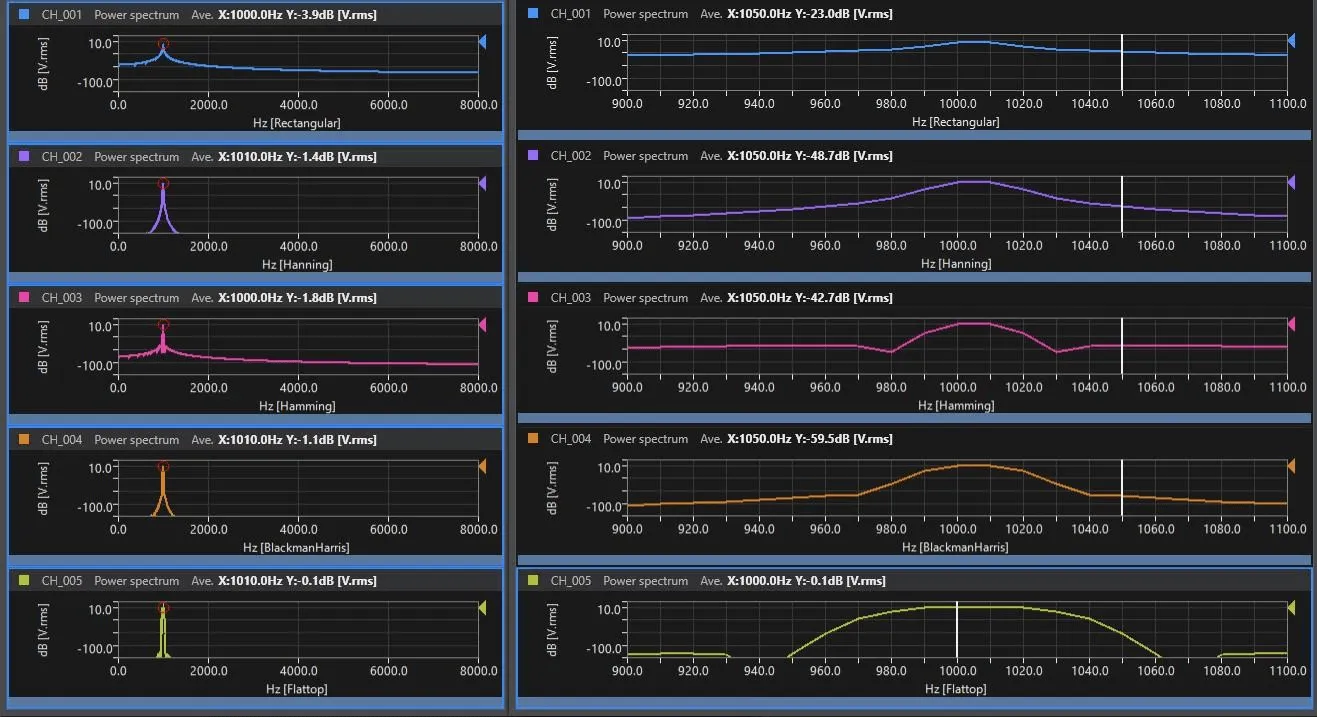No.42 FFT and Time window
In this column, I will introduce how the spectrum changes depending on the type of time window. Please refer to No.41 “FFT and frequency resolution” as well.
https://www.onosokki.co.jp/English/emm_back/emm41.htm
In FFT Analysis (Fourier analysis), the time axis waveform is cut out to a certain length, and the cut out time axis waveform is transformed to obtain the Fourier series. If the cut waveform repeats as it is, the start and end point become discontinuous, and the correct frequency spectrum will not be obtained. As a result, the spectrum has a gentle spread (skirt) on both sides. The magnitude of the peak of the spectrum is decreased compared to the true value, and the power corresponding to the decrease is leaked to both sides. The center of spread is called the main lobe and the hem is called the side lobe.
To reduce the above leakage errors as much as possible, weighting both ends of the cut time waveform to converge to 0 is called "applying time window", and such a weighting function is called "time window" or "time window function".
Explain the features of rectangular, Hanning, Hamming, Blackman Harris and flat top window functions.
The time waveforms analyzed by FFT are sine waves with frequency of 1000 Hz, 1002.5 Hz, and 1005 Hz.
Analyzing with sampling frequency 20480 Hz (frequency range 8000 Hz), sampling points 2048, and frequency resolution 10 Hz.
It can be seen that when the frequency of the time waveform deviates from the center of the frequency resolution, the shape of the spectrum changes and the peak value becomes smaller.
However, the overall value doesn’t decrease since the total power doesn’t decrease.
Figure 1 shows the analysis results for the 1000 Hz of sine wave. 1000 Hz corresponds to the center frequency in FFT analysis, its value is 0.0 dB.
From the top, the results of time window: rectangular, Hanning, Hamming, Blackman Harris and flat top. The frequency axis is enlarged on the right side of the graph.
In the rectangular window (no weighting), there is one outstanding peak. The main lobe is not widened in 990, 1010 Hz.
The main lobe of the Hanning and the Hamming are almost the same. In Blackman Harris, it is wider than Hanning and Humming. In the flat top, it widens greatly in the horizontal direction.
Since 1000 Hz frequency corresponds to the center frequency, there is no decrease in the peak value.

Fig.1
Figure 2 shows the analysis results for the 1002.5 Hz of sine wave.
1002.5 Hz deviates from the center frequency in FFT analysis. Since the frequency resolution is 10 Hz, the frequency is off by 1/4 of the frequency resolution.
The start and end point of time waveform become discontinuous.
From the top, the results of time window: rectangular, Hanning, Hamming, Blackman Harris and flat top.
It can be seen that the peak value decrease less than 0 dB.
In the rectangular window, the both side lobe is greatly wide, so other frequency components are not visible.
In the Hanning, the main lobe is wide, but the both side lobe is narrower.
In the Hamming, the main lobe is narrow, the both side lobe is wider.
In the Blackman Harris, it looks like between Hanning and Hamming.
In the flat top, the main lobe widen greatly, horizontally, but the peak value is hardly reduced.

Fig.2
Figure 4 shows the analysis results for the 1005 Hz of sine wave.
1002.5 Hz deviates from the center frequency in FFT analysis. The frequency is off by half of the frequency resolution (10 Hz).
The discontinuous time waveform is obviously shown in Figure 3.

Fig.3
The decrease in peak value is even greater than 1002.5 Hz.
From the top, the results of the time window: rectangular, Hanning, Hamming, Blackman Harris and flat top.
The decrease in the peak value is noticeable, while it is not much reduced in the flat top window.

Fig.4
Summary
Rectangular window :
It is applied for a single signal that becomes zero at the start and end points of the cut time waveform without weighting. It is useful for hitting test such as hammering test, sound check for connector fitting.
Hanning window :
Compared to Hamming and Blackman Harris, it has a well-balanced lobe width. It is suitable for general noise and vibration measurement.
Flat top window :
It is used when you want to see the peak accurately even if the signal frequency deviates from the center frequency of the FFT resolution.
It is suitable for signal calibration with a single frequency signal, measurement of harmonic distortion rate, etc.
(HK)
